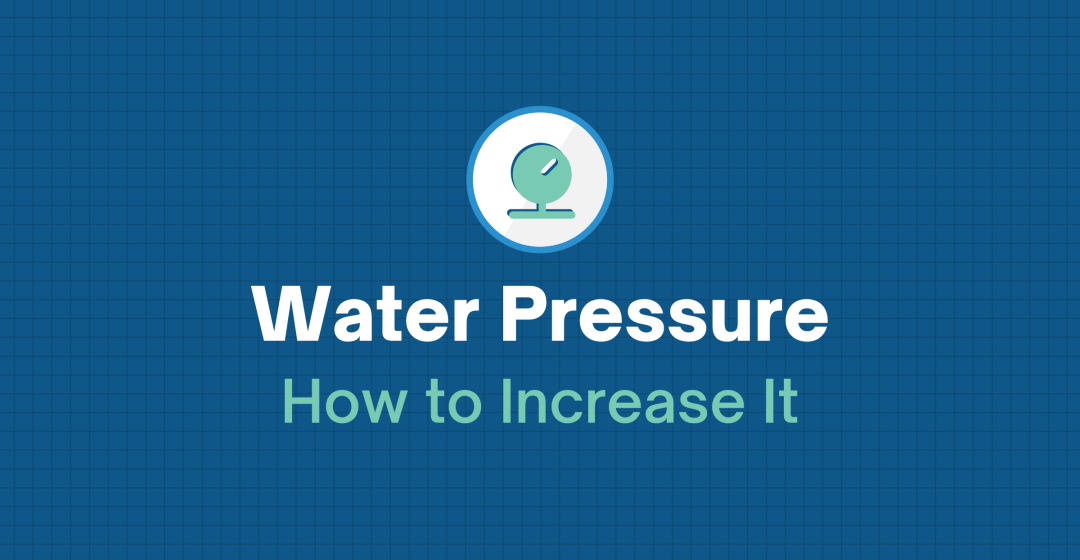How to Increase Water Pressure in Your Home (2020)

What is Water Pressure?
Water pressure is the force at which water is being applied – generally against pipe or fittings in a plumbing system. This is what allows water to move from one place to another at an accelerated rate.
This force is measured by the unit PSI (pounds per square inch). For example, when water is at the pressure of 60 psi, that means the water is applying 60 pounds of force per square inch of surface it contacts.
“Good” water pressure in a home is usually around 50 psi to 70 psi.
Fun Fact: Water utilities are generally only required to provide above 20 psi at the meter, which in many cases is 20 feet or more away from the home.
Here’s the catch when it comes to water pressure, in some cases it’s not actually water pressure that is the issue, but rather flow rate.
What is Water Flow Rate?
Water Flow Rate is how much volume of water is being delivered in a certain amount of time – most often calculated at gallons per minute, or gpm.
For example, a house with a flow rate of 12 gpm means that the 12 gallons of water per minute can be provided in total. So if there is a shower running that uses 2 gpm, the washing machine which uses 3 gpm is running, and the kitchen sink is running at 3 gpm, which means 8 of 12 gallons are currently being used. This can often lead to lower “water pressure” because the flow rate simply can’t keep up.
Flow rate is determined by the pipe diameter, water supply, friction-loss, and other factors.
Why Does My House Have Low Water Pressure?
There are multiple reasons that could explain why you are experiencing low water pressure. Here are 4 things you can do that may help!
1. Check Your Current Water Pressure and Flow Rate
The first step in fixing your water pressure/flow rate issues is to have a good understanding of the current data.
For starters, check the flow rate.
Get a 5-gallon bucket or two, and use an outdoor hose spigot to time how quickly the bucket fills. For example, if you can fill two 5-gallon buckets in 1 minute, that means your home is delivering about 10 gallons per minute (gpm).
TIP: Make sure there is no other water running in your home when you are testing the flow rate.
Lastly, to check the water pressure, you’ll need to use a pressure gauge. If you don’t have access to a pressure gauge, a plumber or water professional will be able to do this for you as well.
2. Check Your PRV (Pressure Reducing Valve)
Most homes are equipped with a PRV (Pressure Reducing Valve). The PRV helps prevent high water pressure which can cause leaks by regulating the water pressure coming into the home.
There are two things you need to know about PRVs:
- PRVs go bad. They should be checked annually with the expectation of replacement every 12 to 20 years.
- PRVs are sometimes turned down too low which can prevent sufficient water pressure in the home. Therefore, make sure to use a water professional or plumber to check your PRV.
3. Check Your Plumbing and Fixtures
Are your pressure and flow issues throughout your whole plumbing system, or are they isolated to a certain faucet or two? In the case of the latter, this could be evidence of a clogged pipe or fixture.
Sometimes the aerator at the tip of the faucet can get clogged from debris that gets into the water supply. This is simple to check and can sometimes be the culprit of low water pressure and flowrate issues.
Other times it can be the pipes themselves which are clogged. Unfortunately, this is a bit harder to diagnose and we would recommend hiring a plumber or water professional to investigate.
4. Check for Leaks
Remember the illustration I used earlier to explain that you only have so much total water flow for your home? Well, if your plumbing system is leaking, this will reduce your flow rate and in turn water pressure.
You can check for leaks by making sure there is no water running in your home, and then check your water meter to see if it’s still indicating that water is being used.
How to Solve Low Water Pressure & Flow
Okay. But what if you have serious water flow rate issues? We’ve had customers who are at the end of the water utility service line, and thus have low water pressure, or their home was on top of a mountain and the service water simply couldn’t fight gravity enough to supply sufficient water pressure.
And finally, we’ve had customers who wanted a larger capacity of water supplied to their home. For example, the supply line would only provide 20 gallons gpm, but they wanted water supply at 30, 40, or 50gpm – how can this problem be solved?
Option 1. Booster Pump (Simple with Limited Applications)
Installing a booster pump may be all you need to increase your water pressure to the correct level.
While this option is limited depending on what you want to accomplish, it can be a great solution for simple pressure boosting.
Option 2. Capacity & Pressure Pump System (Full-Scale Solution) by PerfectWater™
This will completely solve all your water pressure and flow-rate issues, as well as provide ample on-site water storage to increase water availability. These systems are scalable which means that 10,000 gallons of on-site storage with 50+ gpm at a constant 65 psi, no problem.
Or if you want a smaller solution that will provide a constant 20 gpm with sufficient water storage, that is an option as well.
Our capacity and pressure systems are engineered to supply a home with excellent flow rate and water pressure while ensuring there is enough on-site water storage to meet the demand.
Ready to Take Control of Your Water Supply?
Don’t wait for water shortages or unreliable sources to disrupt your life. With our Rainwater Harvesting systems, you can enjoy a sustainable, reliable, and completely self-sufficient water solution tailored to your home’s needs.

